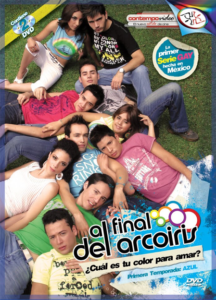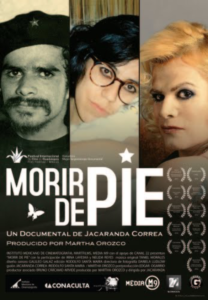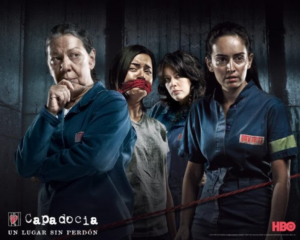On Wednesday 25 October 2017, the ‘Intersecting Identities’ stream welcomed Professor Paul Julian Smith, Distinguished Professor in Latin American, Iberian, and Latino Cultures and Comparative Literature in the Graduate Center of CUNY, New York, who presented material from his forthcoming book, Queer Mexico: Cinema and Television since 2000 (Detroit: Wayne State University Press, 2018). Paul’s presentation gelled brilliantly with the stream, since his book documents how identity is understood through film language in the historical and culturally specific site of Mexico in the new millennium, and attempts to show how markers of gender, sex, and nation intersect through varied and as yet little studied media. His talk complemented the stream’s acknowledged strengths in the related but distinct fields of film, feminism and queer studies (Lisa Downing; Elliot Evans; Kate Ince; Charlotte Ross; Lorraine Ryan).

Paul’s view of the current state of LGBT+ people’s lives in Mexico is that at least in the Historic Center and gay village (Zona Rosa) of the capital, a new Mexico exists for queer people that belies macho or conservative Catholic stereotypes, despite continuing homo- and trans-phobia elsewhere. In Mexico City increased public visibility is matched by marriage equality, a reality since 2010: on a recent visit he made to the viewing platform of Mexico City’s iconic Latin American Tower, once a location for heterosexual romantic comedies such as Alfonso Cuarón’s Solo con tu pareja (1991), no one turned a hair as a young lesbian couple shared a passionate kiss at sunset, and male couples too were smooching in the gathering dusk by the tumbledown 18th century church in the shadow of the Tower. In 2013 the Mexican Supreme Court ruled that the use of homophobic slurs was a violation of fundamental human rights.
Paul elected to write Queer Mexico as a study of the queer audiovisual field in Mexico since 2000 because these important changes in social, cultural, and scholarly background had been neglected by scholars hitherto, and because it seemed urgent to expand the object of study beyond art cinema and feature film more broadly and to address the neglected but vast and influential media of shorts, television, and webnovela. He intends Queer Mexico to be a gesture of respect to the producers and consumers of this newly diverse audiovisual culture, and hopes that readers of his book share his excitement at discovering work that transcends foreign stereotypes of both nationality and sexuality, treating diversity of desire with cinematic and televisual style.
Kate Ince (‘Intersecting Identities’ lead)
Queer Mexico: Cinema and Television since 2000 (2018) by Prof Paul Julian Smith
Queer Mexico combines textual analysis of audiovisual works as aesthetic objects with an institutional account of the conditions of production, distribution, and exhibition of those works across the vibrant cinema and television sectors in a rapidly changing modern Mexico. Crucially, it extends the focus of attention beyond fiction feature films and art cinema to embrace less familiar media such as webnovela, pornography, shorts, documentary, and television series. Queer Mexico thus aims to tease out the relationships between art and commerce, identity and aesthetics, and the artistic and social turns of queer Mexican media that are irreducibly hybrid.
The first of the book’s five chapters treats three discursive contexts for the audiovisual fiction texts that follow: a long lasting LGBT festival (MIX), a web-distributed TV youth drama, claimed by its makers to be the first wholly gay series made in Mexico (Al final del arcoíris), and an equally well established local porn producer (Mecos), a rare thing in Latin America.

All three of these areas refer back to a heritage of queer imagery in Mexico (the porn videos feature lucha libre wrestlers), even as they point forward to new cultural identities. And all are the creation of little known minor entrepreneurs who have cultivated their respective and neglected fields over time.
The second chapter examines selected features and shorts by Mexico’s sole internationally distributed gay art house director, Julián Hernández. Hernández represents a radical challenge to the canonic heterosexual auteurs that are generally taken to represent his country abroad (Reygadas, Escalante), even though his art movies, feted at foreign festivals, are little seen at home. Hernández’s practice of auteur cinema is juxtaposed in this chapter with two parallel narratives: the real life micro-narratives of current queer lives narrated by a social scientist (Héctor Carrillo’s The Night Is Young) and the homosocial “cinemachismo” examined by a scholar of Mexico’s Golden Age cinema of the 1940s (Sergio de la Mora).

Queer Mexico’s third chapter treats the increasing number of Mexican documentaries on transgender themes. While it is often said that documentary in Mexico is more creative than fiction, it is only recently that queer documentaries have made their presence felt. Strikingly, like the “minor genres” treated in the previous chapter, several of these documentary features cite Mexican audiovisual heritage. They thus work through inherited image repertoires in cinema and politics (from child stars of the Golden Age to Che Guevara), even as they push the boundaries of what counts as Mexican national cinema, moving beyond the nation’s geographical borders to Cuba and even Thailand. The texts are: Morir de pie (Jacaranda Correa, 2011), Quebranto (Roberto Fiesco, 2013), and Made in Bangkok (Flavio Florencio, 2015).

Chapter Four charts the growing trend of a gay male-, lesbian-, or trans-focused mainstream cinema. These films reject both the gritty social realism and the tragic melodrama of earlier periods, drawing rather on the massively popular genres of the romantic comedy and the thriller that attract aspirational audiences to theaters. These movies thus offer their target public reassuringly positive images of socially integrated queers. The relatively assimilated characters depicted in this commercial cinema (which include lesbian and gay professionals and a self-confident transgender woman) are also very different from the alienated and isolated protagonists seen in the auteur films of the second chapter. The films are Todo el mundo tiene a alguién menos yo (Raúl Fuentes, 2012), Cuatro lunas (Sergio Tovar Velarde, 2014), Carmín tropical (Rigoberto Perézcano, 2014).
The final, longest chapter of the book examines the rich and diverse history of queer representation in Mexico’s dominant TV genre and, arguably, national narrative: the telenovela. It focuses especially on Argos, a politically progressive independent production company that has been making gay- and lesbian-friendly serial melodramas for some twenty years. Well received and widely distributed, Argos’s TV series have played to audiences in their millions, and it has collaborated over time with a range of television channels in Mexico: from free to air network Azteca, to radical upstart Cadena 3, via boundary-pushing subscription channel HBO Latin America. Despised by the elite in Mexico, television nonetheless serves the vital purpose of inviting the “intimate strangers” that are queer characters into family homes, an opportunity that cinema, of course, is unable to offer. The TV series are: La vida en el espejo (Azteca, 1999), El sexo débil (Cadena 3, 2011),and Capadocia (HBO Latin America, 2008-12).

Kate’s final word for ‘Intersecting Identities’
According to Paul, the ambition of Queer Mexico is to demonstrate the diversity of both representations and production processes in the corpus of audiovisual works it treats, as well as to (re)construct a queer cultural field for Mexico that incorporates multiple texts, producers, and institutions. Mainstream Mexican cultural production alternately marginalizes and promotes this field, and Paul’s presentation of his book contributed wonderfully to ‘Intersecting Identities’’s ongoing research by showing that if queer audiovisual media still enjoys varying fortunes in Mexico, open homophobia is no longer socially acceptable in Mexican cinema.

Join the discussion
0 people are already talking about this, why not let us know what you think?